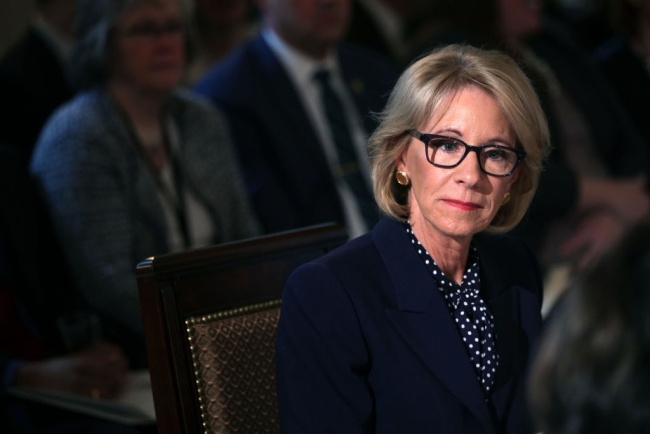You have /5 articles left.
Sign up for a free account or log in.

Education Secretary Betsy DeVos
Getty Images
In her first significant act as Education Secretary more than two years ago, Betsy DeVos said she planned to overhaul an Obama administration student loan rule designed to protect borrowers defrauded by their college.
Despite her efforts, the Obama borrower-defense regulations took effect last year. But on Friday DeVos capped off a two-year effort by issuing her own rule, which scales back loan forgiveness opportunities for student borrowers.
The new regulations significantly raise the bar for student borrowers seeking debt forgiveness based on claims they were defrauded by their colleges. They add a new three-year time limit for those borrowers to file claims, and each case will be considered individually, even if there is evidence of widespread misconduct at an institution.
Borrowers will also be asked to demonstrate they suffered financial harm from their college’s misconduct and that the college made deceptive statements with “knowledge of its false, misleading, or deceptive nature.”
The collapse of the Corinthian Colleges chain and subsequent flood of debt-relief claims prompted Education Department officials under the last administration to issue the 2016 borrower-defense rule.
Although the rule was a response to misconduct in the for-profit college sector, it applied to all Title IV institutions. And private nonprofit college groups had expressed concerns that their institutions could be on the hook for student claims even for unintentional mistakes in marketing materials. DeVos had made clear previously that she thought the regulations were too permissive, essentially offering borrowers the chance at “free money.”
“We believe this final rule corrects the wrongs of the 2016 rule through common sense and carefully crafted reforms that hold colleges and universities accountable and treat students and taxpayers fairly,” she said in a statement accompanying the rule.
Education Department officials said the new three-year time limit for claims aligns with record-retention requirements for colleges. They said the process will give institutions the opportunity to respond to claims and students the chance to elaborate on claims based on those responses.
The DeVos regulations will save the federal government about $11 billion over 10 years, the department estimates (the federal government shoulders the cost of loan discharge if it cannot recoup funds from the institutions themselves). Consumer advocates argue those savings are created by rigging the system against borrowers.
Aaron Ament, president of the National Student Legal Defense Network and a former Obama administration official, said the rule cuts off “nearly every avenue for individual borrowers to assert their rights when they are harmed.”
The Trump administration’s final rule dropped some of the most heavily criticized provisions of a preliminary rule released last year. It didn’t include, for instance, language that suggested only borrowers who had defaulted on their loans would be eligible for debt relief under borrower defense.
But a number of other changes will significantly restrict access to debt relief. The new rule requires students filing borrower-defense claims to demonstrate that they actively sought employment in their field to demonstrate financial harm, not just that they were deceived by their college. It also allows institutions to impose mandatory arbitration agreements if they make disclosures of the provisions in plain language. The 2016 Obama administration rule had banned those provisions, which consumer advocates say limit students’ rights to take colleges to court and potentially expose evidence of wrongdoing.
Before the 2016 rule established a federal standard for misconduct by colleges, borrower-defense claims were based on violations of state law. No claims based on state law will be accepted under the new rule.
“That’s problematic for us,” said Ashley Harrington, senior policy counsel at the Center for Responsible Lending. “The federal standard should be the floor, not the ceiling, for relief.”
The rule also limits debt relief for students whose colleges abruptly closed while their degrees were still in progress. A process known as closed-school discharge allows those students to apply to have their federal student loans canceled if they were still enrolled or withdrew shortly before the college’s closure.
The Trump administration rule extends the window for closed-school discharge from 120 days to 180 days of the college's closure date. But it drops a provision from the Obama rule that would have extended automatic debt cancellation to eligible borrowers who hadn’t re-enrolled in another institution within three years. After the 2016 rule took effect last fall, students who attended colleges that closed precipitously received more than $150 million in debt relief.
The rewrite of the borrower-defense rule was arguably the most significant piece of a drastic change in course on regulation of colleges -- and, specifically, the for-profit sector -- under the Trump administration. DeVos in June rescinded the gainful-employment rule, which would have cut off federal aid to career education programs whose graduates held unmanageable student debt. And the Education Department is finalizing new regulations that will loosen federal standards for college accreditors, the gatekeepers for Title IV student aid.
Michael Dakduk, executive vice president and director of government relations at Career Education Colleges and Universities, said the rule appeared to address several concerns CECU had expressed about the 2016 regulations.
“We believe this administration's rewrite provides the necessary safeguards for students and taxpayers while generally ensuring appropriate due process for institutions,” he said.
Although the regulations applied to all colleges receiving federal aid, they were widely seen as protections against abusive for-profit colleges. And data from the Education Department show the vast majority of borrower-defense claims have been filed by former students of for-profit colleges.
DeVos said Friday that fraud in higher ed wasn’t limited to one sector, comparing efforts to game college rankings to deceptive marketing by for-profit institutions.
“From the recent college admissions scandal and intentional misrepresentations by schools to boost their U.S. News & World Report rankings to fraudulent marketing practices from proprietary intuitions, too many institutions of higher education are falling short,” she said in her statement. “The new regulations are aimed at preventing this behavior, because students deserve better, and all institutions must do better.”
Harvard University’s Project on Predatory Student Lending said it planned to sue to block the rule from taking effect. The organization was part of the lawsuit last year that forced the Trump administration to carry out the 2016 rule, and it has brought several other lawsuits against DeVos on behalf of student borrowers.
Eileen Connor, the project’s legal director, said DeVos was “shredding a set of fair, common-sense rules that level the playing field between students and those who take advantage of them.”
The Trump administration’s rule is slated to go into effect in July 2020 and would apply to all claims submitted after that date. That means three different standards for loan relief will apply depending on when a student’s loans were disbursed.
Student loans made before July 1, 2017, will be considered under the pre-2016 standards. Loans disbursed between July 2017 and July 1, 2020, will be subject to the Obama rule. And loans disbursed beginning July 1 of next year will be subject to the Trump administration regulations.
More than 150,000 outstanding claims are currently pending a decision at the Education Department. Some borrowers have sued the department after years of waiting for a decision on their claims. Those lawsuits have resulted in loan discharge for a handful of students, although not borrowers as a class.
The Trump administration hasn’t issued any new approvals for loan relief since May 2018, when a federal judge ruled a partial debt-relief formula introduced by DeVos was unlawful.
“We have been diligently working to see if there is a different methodology we can use so we can resolve those claims,” said Diane Auer Jones, the department’s deputy under secretary.








